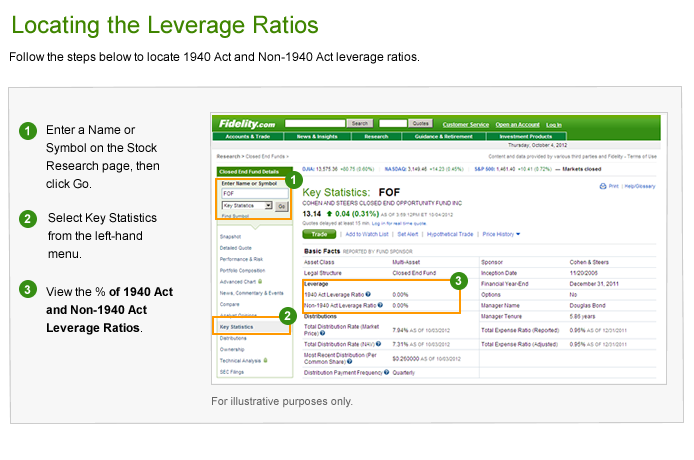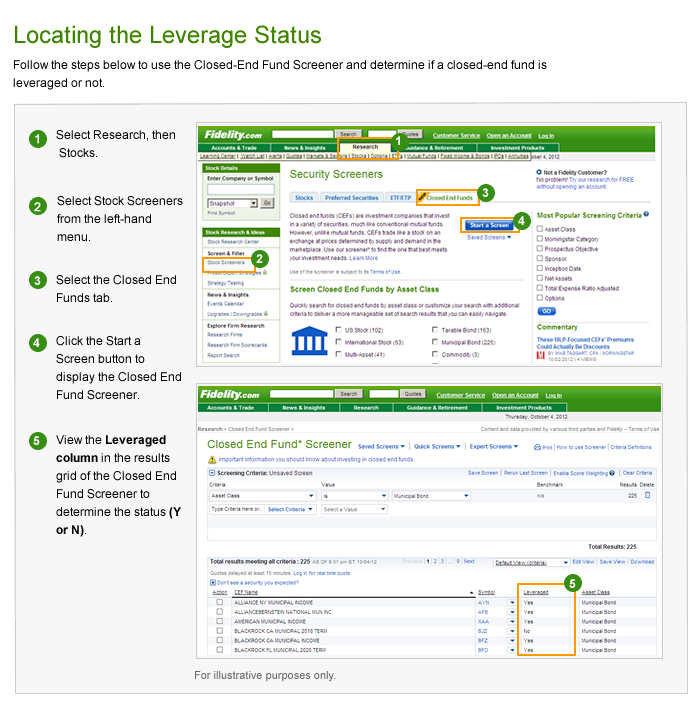Many income-seeking investors are drawn to closed-end funds (CEFs) because their relatively high distribution rates. High distribution rates are often the result of CEFs' use of leverage via the issuance of debt or preferred shares. Leverage has upsides and downsides. By leveraging an underlying portfolio, a manager has more capital to work with and can invest in more securities that produce income for the fund. NAV returns can positively benefit from leverage.
Leverage also has drawbacks:
- NAV returns can be negatively affected by leverage
- NAV returns will be more volatile, whether positively or negatively, relative to a similar but unleveraged fund
- Payments must be made to the providers of the leverage
- If a fund is forced to sell assets to maintain covenants for its leverage, the fund's capital may be permanently impaired
Industry studies show that over a long period of time, the benefits of leverage outweigh the drawbacks.
What is leverage?
Leverage simply means that an investment portfolio is larger than its net asset base. The fund raises additional capital through a debt issuance, a preferred share issuance, or by using sophisticated financial products to increase the value of its underlying portfolio.
Say, for example, a fund has net assets of $500 million, raised in an initial public offering of 50 million common shares.
- It then issues $250 million of preferred shares
- Total capital is then $750 million
- Common shares outstanding are 50 million
- Total capital per share is $15.00
- Net asset value per share = (Total capital − liabilities (preferred shares)) ÷ shares outstanding = ($750 million − $250 million) ÷ 50 million = $500 million ÷ 50 million = $10.00
This CEF has a leverage ratio of 50%, computed as capital from preferred shares divided by net asset value: $5 from preferred shares ÷ $10 in net asset value = 50%
Leverage magnifies returns, both positively and negatively. In other words, a leveraged fund exhibits more volatility than would an unleveraged fund investing in the same securities. The table below shows how the effect works on the upside and downside.
| Unleveraged fund | Leveraged fund | |
|---|---|---|
| Net assets ($mil) | $100 | $100 |
| Shares outstanding (millions) | 10 | 10 |
| NAV (beginning) | $10 | $10 |
| Leverage ($mil) | $0 | $50 |
| Total assets (net assets + liabilities) | $100 | $150 |
| Leverage ratio | 0% | 50% |
| NAV (leveraged)* | $10.00 | $10.00 |
| Effects of a 10% increase in total assets | $10 | $15 |
| Total assets | $110 | $165 |
| NAV | $11 | $11.50 |
| Return | 10% | 15% |
| Effects of a 10% decrease in total assets | -$10 | -$15 |
| Total assets | $90 | $135 |
| NAV | $9 | $8.50 |
| Return | -10% | -15% |
* Absent portfolio value changes. NAV is the same whether leveraged or unleveraged.
Using leverage in a portfolio can also lead to higher distribution rates. The portfolio's underlying yield—and this is a true yield—can be magnified through leveraged assets, as shown in the table below.
| Unleveraged fund | Leveraged fund | |
|---|---|---|
| Net assets ($mil) | $100 | $100 |
| Shares outstanding (millions) | 10 | 10 |
| NAV (beginning) | $10 | $10 |
| Leverage ($mil) | $0 | $50 |
| Total assets (net assets + liabilities) | $100 | $150 |
| Leverage ratio | 0% | 50% |
| NAV (leveraged)* | $10 | $10 |
| Total assets yield 7% | ||
| Income | $7 | $10.50 |
| Cost of leverage at 3% | $0 | $1.50 |
| Income minus cost of leverage (net income) | $7 | $9 |
| Net income per share | $0.70 | $0.90 |
| Portfolio yield | ||
| Net income per share | $0.70 | $0.90 |
| Net assets | $10 | $10 |
| Yield | 7% | 9% |
* Absent portfolio value changes. NAV is the same whether leveraged or unleveraged.
Why can CEFs use leverage?
Because of their closed-end structure, CEFs are allowed by law to use leverage. Specifically, according to the Investment Company Act of 1940—which provides the framework for CEFs, mutual funds, and ETFs—CEFs are allowed to issue:
- Debt in an amount up to 50% of net assets
- Preferred shares in an amount up to 100% of net assets
In practice, the average leveraged CEF carries 33% total leverage. For every $1 of net assets, they have another $0.33 in leveraged capital.
Non-'40 Act leverage
Leverage achieved through debt and preferred shares is commonly referred to as "'40 Act leverage," after the Investment Company Act of 1940. There are other methods by which a fund can leverage its net assets. This is referred to as "Non-'40 Act leverage." Whereas the provisions for leverage within the '40 Act were meant to safeguard the integrity of a fund's capital structure, non-'40 Act leverage is unrelated to the capital structure. It arises, instead, from the fund's portfolio of investments. Examples of non-'40 Act leverage include:
- Tender option bonds
- Reverse repurchase agreements
- Securities lending obligations
Transparency
Leverage is leverage. Regardless of the source of the leverage, it has the same effects on a portfolio as outlined earlier in this presentation. This is why transparency of a fund's true leverage is so important. Only '40 Act leverage is required by law to be reported. All leverage is actually reported on the financial statements, but only '40 Act leverage needs to be reported as "leverage." Fund families have wide discretion in how they choose to actively report non-'40 Act leverage. Their websites may say a fund is unleveraged, when it actually has a lot of non-'40 Act leverage.
One simple way for investors to check leverage ratios is the following:
Total leverage = total assets / net assets
The closer the value is to 1, the lower the leverage.
To locate ratio information for a specific CEF, go to our ETF Research Center, enter the symbol, then find the Composition or Statistics tabs.
Leverage, interest expense, and expense ratios
According to the Investment Company Act of 1940, CEFs that issue debt to achieve leverage must include the interest expense that they pay on that debt in their expense ratios. This raises 2 issues:
- Leverage achieved through preferred share issuance does not have to be included, even though common shareholders experience that payment to preferred shareholders just like they experience the payments to bond creditors.
- The inclusion of the interest expense makes comparison to non-leveraged CEFs and mutual funds difficult and confusing. To help make it easier, we include both reported expense ratios and adjusted expense ratios on Morningstar.com. The adjusted expense ratio excludes the interest expense.
Even though interest expense is a true expense, it also brings a benefit: the excess gain achieved from the leverage. To assess the true benefit of the leverage, one must calculate the excess return from the leverage and then subtract the cost of that leverage. Is the leverage actually an expense? In the example that follows, the leverage actually contributed net income of $3 million to the fund during the period. In fact, as long as the total return of the portfolio exceeds the cost of the leverage, using leverage will be profitable. While interest expense is definitely an expense, it's an expense that can have calculable benefits.
| Leveraged fund | ||
|---|---|---|
| Net assets ($mil) | $100 | |
| Shares outstanding (millions) | 10 | |
| NAV per share | $10 | |
| Leverage ($mil) | $50 | |
| Total assets (net assets + liabilities) | $150 | |
| Leverage ratio | 50% | |
| NAV (leveraged)* | $10 | |
| NAV total return of 10% | ||
| Total assets increased 10% | $15 | |
| Amount contributed by net assets | $10 | |
| Amount contributed by leveraged assets | $5 | |
| Leverage costs | ||
| $50 million of debt issued at 5% interest | ||
| Annual interest expense | $2 | |
| Net benefits of the leverage | ||
| Amount contributed by leveraged assets | $5 | |
| Annual interest expense | $2 | |
| Net benefit | $3 |
* Absent portfolio value changes. NAV is the same whether leveraged or unleveraged.
Key takeaways
- Adding leverage to a CEF's portfolio will increase volatility of NAV returns.
- Adding leverage can also enhance a CEF's distribution rate.
- There are costs to adding leverage to a portfolio.
- While the Investment Company Act of 1940 allows CEFs to issue debt and preferred shares (with certain limitations), CEFs can also use non-'40 Act leverage.
- Regardless of the source of the leverage, the effects will be the same.
- In times of extreme market distress, a leveraged fund may be forced to liquidate holdings to meet leverage coverage ratios. In such rare cases, the benefits of the closed-end structure eviscerate, and the capital is permanently impaired. In 2008 and 2009, this happened to a few leveraged high-yield ("junk bond") CEFs.
- While many investors are rightfully cautious about leverage, it's important to understand that the average leveraged CEF is only 33% leveraged.




